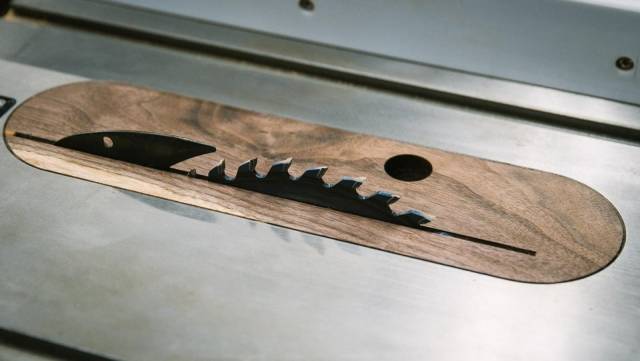(This site is reader-supported. When you buy something using retail links on our articles, we may earn a small commission. As an Amazon Associate I earn from qualifying purchases.)
Whether you are into woodworking or all kinds of DIY projects for your house, a riving knife can certainly add to your experience now and then. But then, what is a riving knife? Why would you need one and how can you use it without injuring yourself?
What is a riving knife?
The riving knife will usually go on your table saw. It is metallic and flat and it will go by the saw blade. As you push a piece of wood through the saw blade, the riving knife will keep the cut sections from closing up.
If you do lots of woodworking with your table saw, you have probably experienced the kickback already. This is the type of experience that will make your heart pounding. In the worst possible situation, it will draw your hand into the blade, so your fingers will end up flying all across the room. In a less severe situation, it could throw a piece of wood into your nose or your chest.
A riving knife will prevent such a disaster. There are, however, a few considerations when fitting a riving knife on your saw table. It must be the same width as your blade. It should wrap around it at a close distance and it must raise and lower with the blade. Furthermore, the knife must now go past the blade top.
Despite being able to prevent such issues, a riving knife is not perfect and it cannot prevent them entirely. Installing such a knife does not mean that all the risk is gone. A kickback may still occur. Stick to safety clothing, goggles, and hearing protection if you have to, but also stay away from the saw blade. Adopt a position that will keep you safe if the board kicks back.
How riving knives work?
The classic riving knife will mount on the trunnion of your saw. This mechanism goes under the table and pushes the blade up and down. The riving knife has a simple system that allows adjusting it. It normally depends on the saw blade – higher or lower.
As a general rule of thumb, there has to be a gap between the riving knife and the saw blade throughout the entire surface – normally less than 0.25 inches.
Since the distance is low and the knife attaches to the mechanism moving the blade, the knife should practically hug the blade, regardless of the position. From many points of view, the riving knife is similar to a splitter. However, the difference is the splitter has to be removed for crosscutting, while the riving knife can stay there.
When to use a riving knife?
If you watch woodworking shows, you have probably noticed that most experts remove the riving knife. Blade guards and other forms of protection are also removed. It does not mean that you have to do it too. Instead, they do it for greater visibility for the watchers, but they take a risk.
Generally speaking, the riving knife should be used at all times – with a few exceptions. Standard rip cuts? You need it. Crosscuts? You need it. It will not obstruct you and it can seriously enhance your safety standards.
There are also a few situations when it has to go. If you use a stacked dado blade, you should know that it cannot create a through cut. At this point, the riving knife is useless. It might be in your way a little. Moreover, the distance between the riving knife and the blade would be too high, so the knife would not help too much.
2024’s 3 Best Riving Knives
Delta 78-965
This riving knife makes an excellent addition to your table saw. It weighs just over 10 ounces and it is easy to install with no prior experience at all.
Compatibility
Make sure you have the right distance between holes when buying a new riving knife. This model is most suitable for the new generation saws. It is also a good match for lots of thin-kerf blades.
Thin profile
The riving knife should match the blade in thickness. This model is 0.08 inches in thickness and fits most kerf blades.
Pros
- Easy to install
- Durable design
- Fits most kerf blades
- Ideal for new generation saws
Cons
- Not the best choice for older saws
Jet 708683
Jet’s riving knife leaves no room for interpretation. The knife thickness is 0.1 inches and the maximum blade diameter is 10 inches.
No more kerf waste
The knife is excellent for thin blades to keep the kerf waste to a minimum. It is suitable to even the thinnest blades out there.
Durable
Fitting it to the blade is the most difficult part, as you must ensure the size is right. Get it right and the riving knife will last for ages.
Pros
- Excellent for lots of thin blades
- Durable design
- Great at reducing kickback
- Lightweight
Cons
- A little challenging to install
Makita 345940-8
Makita’s original authorized part will match lots of proprietary models like a glove. It may also work for other manufacturer’s saws.
Compatibility
For maximum efficiency, double-check your Makita saw and find out what parts work with it. It will be compatible with most modern saws.
High quality
Just like anything else from Makita, this riving knife will impress with its solid build. Heavier than average, it is likely to last for ages.
Pros
- High quality build
- Compatible with many Makita saws
- Suitable to other saws too
- Durable design
Cons
- A bit difficult to install
Conclusion
So, what is a riving knife? The riving knife is mostly about safety and protection. It will reduce most risks to a minimum level, but it will also add to your working efficiency in the long run.

Hi, I am Jay. I am the creator of Knife Guides, your one-stop site for everything related to knives. I am a computer engineer by profession, knife aficionado by passion. Here I work with a group of people who’ve always had a passion for knives and blades. Over the years we’ve kind of become experts and decided to share our knowledge and ideas. I am also an avid hiker and enjoy offshore gamefishing.





